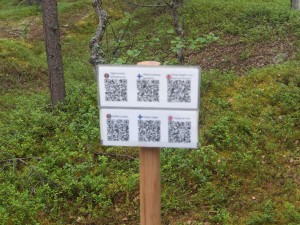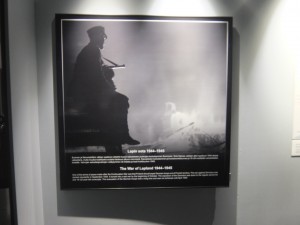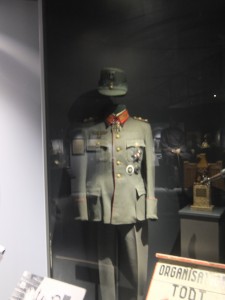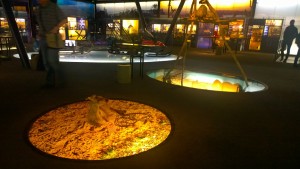Project researchers Suzie Thomas and Eerika Koskinen-Koivisto have visited Siida, the Sámi Museum and Nature Centre in Inari, the Gold Prospector Museum in Tankavaara, and the Military Museum in Helsinki.
We were interested to see how the Lapland War and the period of German presence before it were interpreted and treated in these three different museums. Obviously the Lapland War and the German presence are not central themes to all museums in Finland or indeed Lapland specifically, but given the significant impact of the events of the Second World War on communities and landscapes (for example through evacuation and the ‘scorched earth’ tactics of the retreating German military), it is reasonable to imagine that there would be some acknowledgement of this tumultuous period.
In Siida, we spent time getting to know the whole museum – which has indoor permanent and temporary exhibition spaces as well as an open air museum section – and noting in particular the places in which the Second World War was mentioned. In the outdoor museum section, alongside the traditional Sámi buildings, there is also a trench from the Second World War. Although there is little information on the ground about this particular feature, there is a mobile app available – and the text is reproduced online for those unable to access the app while visiting.

Sign with app for Second World War information at the outdoors section of Siida. Photo: Suzie Thomas, August 2015.
Within the permanent indoor exhibition spaces, the War, and the experiences in Lapland especially concerning the Sámi communities (such as the evacuation of the Skolt Sámi as a result of territories gained by the USSR), are mentioned, but are clearly not a central theme to the overall interpretation offered.
Similarly in Tankavaara at the Gold Prospector Museum, there is only very brief mention of the Second World War within the main exhibition. The museum has not chosen its impact on the various communities in Lapland (including gold prospectors), notably through the mass destruction of the Lapland War, as a central theme to discuss.
The first main exhibition area of the Gold Prospector Museum focuses on the story of gold prospection in Lapland, and in particular provides biographies of notable individual gold prospectors. One individual mentioned is German national Werner Thiede, who came to Finland in 1936, but as the exhibition panel explains, was expelled in 1939, with (according to the interpretation panel) “the threat of war and German state policy” as “the ghosts in the background” to his expulsion. Even more interestingly, it turns out that a gold prospector’s hut close to the museum building – and a rare survivor of the Lapland War devastation – belonged to none other than Thiede, and there were apparently rumours that he had used personal contacts within the German military to ensure that it was not burned down.

Thiede’s gold prospector hut, situated next to the Gold Prospector Museum. A rare survivor of the Lapland War. Photo: Suzie Thomas, August 2015.
Close to the Gold Museum are various hiking paths, including the War Trail for 2 km, which highlights some of the features left from that period. The trail is organised by Metsähallitus in partnership with the Gold Museum, the Sodankylä Municipality and the Centre for Economic Development, Transport and the Environment.
Most recently we have been to the Military Museum in Helsinki – the largest military museum in Finland and a part of the National Defense University. This museum, founded in 1929, covers military and war history for the entire country, and as might be expected features large exhibition spaces for both the Winter and Continuation Wars (1939-40 and 1941-44 respectively). The Lapland War is acknowledged as one of three wars affecting Finland during the Second World War, and there are notable exhibits within the museum, such as the uniform of Colonel General Eduard Dietl (commander of the German Army in Lapland). However, the Lapland War does not get the same amount of coverage as the other two wars, and there is almost no mention of the destruction caused by the retreating German soldiers (although mine clearing in the years after the war is mentioned).

Interpretation panel on the Lapland War, Military Museum, Helsinki. Photo: Suzie Thomas, October 2015.

Uniform of Eduard Dietl, commander of the German troops in Finland during the Second World War. Photo: Suzie Thomas, October 2015.
We plan to make a detailed study and discussion of the extent to which the Lapland War and the experience of northern Finland in the Second World War are featured in a selection of permanent museum exhibitions in a forthcoming journal article.


